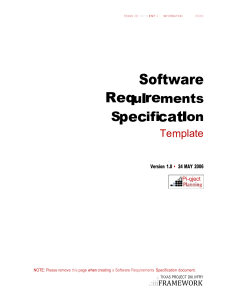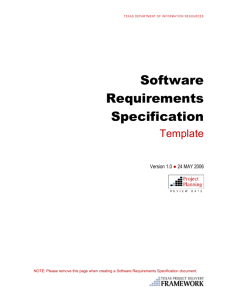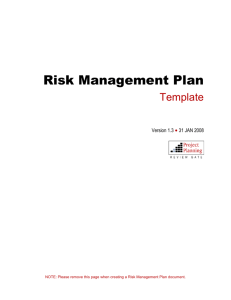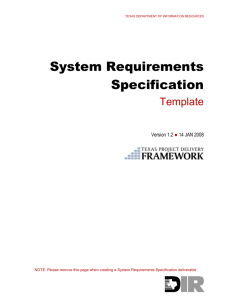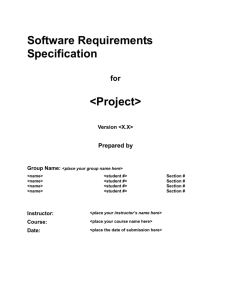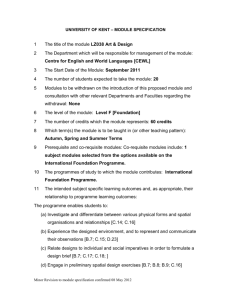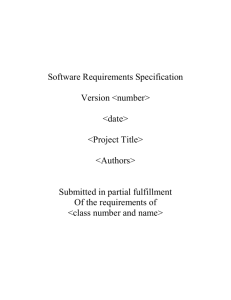Section 3. User Requirements - MVNU Computer Science Department
advertisement
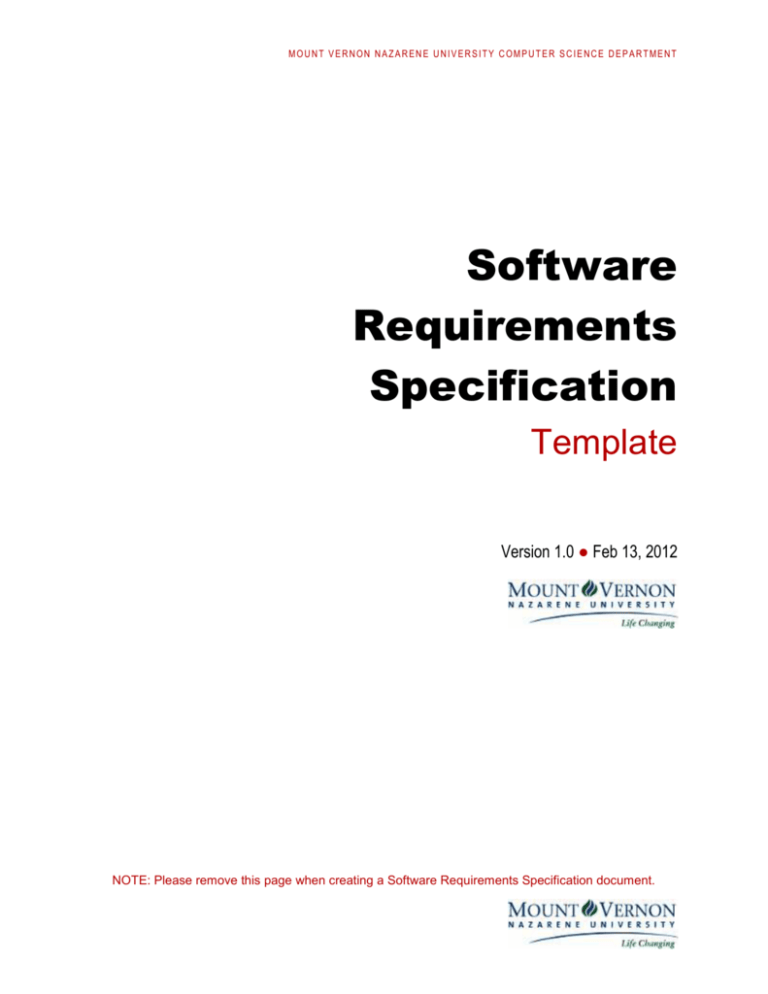
MOUNT VERNON NAZAREN E UNIVERSITY COMPUTER SCIE NCE DEPARTMENT Software Requirements Specification Template Version 1.0 ● Feb 13, 2012 NOTE: Please remove this page when creating a Software Requirements Specification document. Texas Project Delivery Framework SOFTWARE REQUIREMENTS SPECIFICATION Using This Template The companion document, Software Requirements Specification Instructions, provides detailed direction for completing this template. This and other Framework documents, including a glossary, are available at www.dir.state.tx.us/pubs/framework/. To create a document from this template: 1. Delete the template title page (previous page) and this page. 2. Replace [bracketed text] on the cover page (next page) with your project and agency information. 3. Replace [bracketed text] in the document header area at the top of page i (Contents page) with the same project and agency information as on the cover page. Note: Please do not remove or modify content in the footer area. 4. Complete the entire template. Each section contains abbreviated instructions and a content area. The content area is marked with a placeholder symbol () or with a table. Relevant text from other project documents may be pasted into content areas. 5. Update the table of contents by right-clicking and selecting “Update Field,” then “Update Page Numbers Only.” NOTE: Please remove this page when creating a Software Requirements Specification document. DIR Document 25SR-T1-0 MV NU C omp ute r Sc ien ce Dep artm ent SOFTWARE REQUIREMENTS SPECIFICATION [Agency/Organization Name] [PROJECT NAME] VERSION: [Version Number] Approver Name Title REVISION DATE: [Date] Signature Date [Agency/Organization Name] [Project Name] SOFTWARE REQUIREMENTS SPECIFICATION [Version Number] | [Revision Date] Contents Section 1. Overview .............................................................................................1 1.1 Purpose ...............................................................................................1 1.2 Business Context ................................................................................1 1.3 Scope ..................................................................................................1 1.4 User Characteristics ............................................................................1 Section 2. Assumptions, Dependencies, Constraints ..........................................2 2.1 Assumptions........................................................................................2 2.2 Dependencies .....................................................................................2 2.3 Constraints ..........................................................................................2 Section 3. User Requirements .............................................................................3 Section 4. System Architecture ............................................................................3 4.1 Proposed System Architecture ...........................................................3 Section 5. System Requirements .........................................................................3 5.1 Business Requirements ......................................................................3 5.2 Functional Requirements ....................................................................3 5.3 Logical Data Requirements .................................................................4 5.4 User Requirements .............................................................................4 5.5 Information Management Requirements ............................................4 5.6 Non-functional Requirements .............................................................5 5.7 Interfaces ............................................................................................5 5.8 Other Requirements ............................................................................5 Section 5. References ..........................................................................................6 Section 6. Glossary ..............................................................................................7 Section 7. Revision History ..................................................................................8 Section 8. Appendices .........................................................................................9 Based on DIR Document 25SR-T1-0 Page i [Agency/Organization Name] [Project Name] SOFTWARE REQUIREMENTS SPECIFICATION [Version Number] | [Revision Date] Section 1. Overview 1.1 Purpose Specify the purpose of this Software Requirements Specification (SRS) and its intended audience. 1.2 Business Context Provide an overview of the business organization sponsoring the development of the software application, including the mission statement and organizational objectives of the business unit. 1.3 Scope Describe the scope of the software application to be produced. 1.4 User Characteristics Identify each type of user of the software by function, location, and type of device. Specify the number of users in each group and the nature of their use of the software. Based on DIR Document 25SR-T1-0 Page 1 [Agency/Organization Name] [Project Name] SOFTWARE REQUIREMENTS SPECIFICATION [Version Number] | [Revision Date] Section 2. Assumptions, Dependencies, Constraints 2.1 Assumptions Describe the assumptions that can affect the requirements specified in this SRS. 2.2 Dependencies Describe the dependencies that can affect the requirements specified in this SRS. 2.3 Constraints Describe the constraints that can affect the requirements specified in this SRS. Based on DIR Document 25SR-T1-0 Page 2 [Agency/Organization Name] [Project Name] SOFTWARE REQUIREMENTS SPECIFICATION [Version Number] | [Revision Date] Section 3. User Requirements List the user requirements from a users perspective.. Section 4. System Architecture 4.1 Proposed System Architecture Should include appropriate drawings and descriptions to clearly articulate the proposed system architecture.. Section 5. System Requirements 5.1 Business Requirements Describe all business requirements for the software. 5.2 Functional Requirements Customize this subfunction to contain the subfunctions necessary to comprehensively define the fundamental actions that must take place within the software to accept and process the inputs and to process and generate the outputs. Subfunction templates for each of the means of specifying functional requirements are provided below. 5.2.xf Function X When functional decomposition is used as the means of specifying the functional requirements provide a 3.2.xf subfunction for each function. Each 3.2.xf subfunction should be labeled and titled appropriately for a specific function, where xf is the appropriate sequential subfunction number and X is the name of the specific function. 5.2.xf.1 Function X Purpose Describe the intent of the function. Based on DIR Document 25SR-T1-0 Page 3 [Agency/Organization Name] [Project Name] SOFTWARE REQUIREMENTS SPECIFICATION [Version Number] | [Revision Date] 5.2.xf.2 Function X Inputs Describe the inputs to the function. 5.2.xf.3 Function X Operations Describe the operations to be performed within the function. 5.2.xf.4 Function X Outputs Describe the outputs from the function. 5.2.xu Use Case Y When use cases are used as the means of specifying the functional requirements, provide a 3.2.xu subfunction for each use case. Each 3.2.xu subfunction should be labeled and titled appropriately for a specific use case, where xu is the appropriate sequential subfunction number and Y is the name of the specific use case. Within each use case subfunction, specify the use case information, including the actor, preconditions, post-conditions, scenarios, and alternate scenarios. 5.3 Logical Data Requirements Describe the logical data requirements for the software. 5.4 User Requirements Describe the user requirements for the software. 5.5 Information Management Requirements Describe the information management requirements for the software. Based on DIR Document 25SR-T1-0 Page 4 [Agency/Organization Name] [Project Name] 5.6 SOFTWARE REQUIREMENTS SPECIFICATION [Version Number] | [Revision Date] Non-functional Requirements 3.6.1 Performance Requirements Describe the performance conditions and their associated capabilities. 3.6.2 Quality Requirements Describe requirements for the quality characteristics of the software. 5.7 Interfaces Describe the logical characteristics of each interface between the application and other hardware, software, and communication protocols. 5.8 Other Requirements Identify any other requirements that do not fit appropriately into the preceding requirement sections. Based on DIR Document 25SR-T1-0 Page 5 [Agency/Organization Name] [Project Name] SOFTWARE REQUIREMENTS SPECIFICATION [Version Number] | [Revision Date] Section 5. References Provide a list of all documents and other sources of information referenced in the SRS and utilized in developing the SRS. Include for each the document number, title, date, and author. Document No. Based on DIR Document 25SR-T1-0 Document Title Date Page 6 Author [Agency/Organization Name] [Project Name] SOFTWARE REQUIREMENTS SPECIFICATION [Version Number] | [Revision Date] Section 6. Glossary Define of all terms and acronyms required to interpret the SRS properly. Based on DIR Document 25SR-T1-0 Page 7 [Agency/Organization Name] [Project Name] SOFTWARE REQUIREMENTS SPECIFICATION [Version Number] | [Revision Date] Section 7. Revision History Identify changes to the SRS. Version Date Based on DIR Document 25SR-T1-0 Name Description Page 8 [Agency/Organization Name] [Project Name] SOFTWARE REQUIREMENTS SPECIFICATION [Version Number] | [Revision Date] Section 8. Appendices Include any relevant appendices. Based on DIR Document 25SR-T1-0 Page 9
